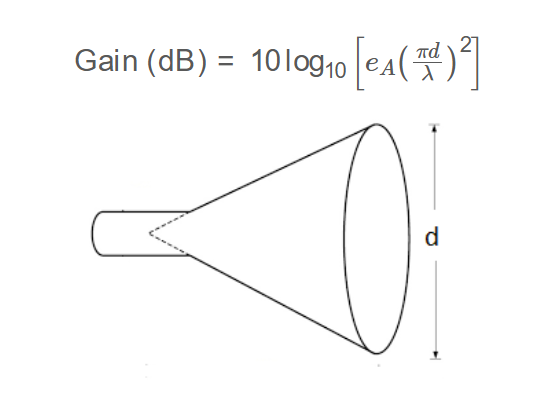1. What is the Conical Horn Antenna Gain Calculator?
Definition: This calculator computes the gain of an ideal conical horn antenna based on its operating frequency, aperture diameter, and aperture efficiency.
Purpose: It assists RF engineers, technicians, and students in designing conical horn antennas for applications such as radar systems, satellite communications, and microwave links, by providing a quick estimate of the antenna gain.
2. How Does the Calculator Work?
The calculator uses the formula:
\( \text{Gain } (\text{dB}) = 10 \log_{10} \left[ e_A \left( \frac{\pi d}{\lambda} \right)^2 \right] \)
Where:
- \( \text{Gain} \): Antenna gain in dB
- \( e_A \): Aperture efficiency (unitless, 0 to 1)
- \( d \): Diameter of the aperture (m)
- \( \lambda \): Wavelength (m), calculated as \( \lambda = \frac{c}{f} \)
- \( c \): Speed of light (\( 299,792,458 \, \text{m/s} \))
- \( f \): Operating frequency (Hz)
Steps:
- Enter the operating frequency (\( f \)) and its unit (Hz, kHz, MHz, GHz).
- Enter the aperture diameter (\( d \)) and its unit (cm, m, mm, in, ft).
- Enter the aperture efficiency (\( e_A \)), typically between 0 and 1.
- Convert frequency to Hz and diameter to meters.
- Compute the wavelength: \( \lambda = \frac{c}{f} \).
- Calculate the gain using the formula.
- Display the result, formatted in scientific notation if the value is less than 0.001 or greater than 10000, otherwise with 4 decimal places.
3. Importance of Antenna Gain Calculation
Calculating the gain of a conical horn antenna is essential for:
- Antenna Design: Determining the performance and directivity of the antenna for specific applications.
- System Performance: Ensuring the antenna meets the gain requirements for communication or radar systems.
- Efficiency Optimization: Understanding the impact of aperture efficiency on antenna performance.
- RF Applications: Optimizing signal transmission and reception in microwave and satellite systems.
4. Using the Calculator
Example 1: Calculate the gain for a typical conical horn antenna:
- Frequency: \( f = 10 \, \text{GHz} \)
- Aperture Diameter: \( d = 10 \, \text{cm} \)
- Aperture Efficiency: \( e_A = 0.5 \)
- Calculation:
- Convert frequency to Hz: \( f = 10 \times 10^9 = 10^{10} \, \text{Hz} \)
- Convert diameter to meters: \( d = 0.1 \, \text{m} \)
- Wavelength: \( \lambda = \frac{299,792,458}{10^{10}} = 0.0299792458 \, \text{m} \)
- \( \frac{\pi d}{\lambda} = \frac{\pi \times 0.1}{0.0299792458} \approx 10.4719 \)
- \( \left( \frac{\pi d}{\lambda} \right)^2 \approx 109.6617 \)
- \( e_A \left( \frac{\pi d}{\lambda} \right)^2 = 0.5 \times 109.6617 \approx 54.8309 \)
- Gain: \( 10 \log_{10}(54.8309) \approx 10 \times 1.7391 \approx 17.391 \, \text{dB} \)
- Result: Antenna Gain = 17.3910 dB
Example 2: Calculate for a larger antenna:
- Frequency: \( f = 5 \, \text{GHz} \)
- Aperture Diameter: \( d = 20 \, \text{cm} \)
- Aperture Efficiency: \( e_A = 0.6 \)
- Calculation:
- Convert frequency to Hz: \( f = 5 \times 10^9 = 5 \times 10^9 \, \text{Hz} \)
- Convert diameter to meters: \( d = 0.2 \, \text{m} \)
- Wavelength: \( \lambda = \frac{299,792,458}{5 \times 10^9} = 0.0599584916 \, \text{m} \)
- \( \frac{\pi d}{\lambda} = \frac{\pi \times 0.2}{0.0599584916} \approx 10.4719 \)
- \( \left( \frac{\pi d}{\lambda} \right)^2 \approx 109.6617 \)
- \( e_A \left( \frac{\pi d}{\lambda} \right)^2 = 0.6 \times 109.6617 \approx 65.7970 \)
- Gain: \( 10 \log_{10}(65.7970) \approx 10 \times 1.8181 \approx 18.181 \, \text{dB} \)
- Result: Antenna Gain = 18.1810 dB
5. Frequently Asked Questions (FAQ)
Q: Why are frequency and diameter restricted to positive values?
A: Frequency and diameter must be greater than zero to be physically meaningful and to avoid division by zero or negative wavelengths in the formula.
Q: Why is aperture efficiency limited to 0 to 1?
A: Aperture efficiency represents the effectiveness of the antenna's aperture in converting incoming power to radiated power, and it cannot be less than 0 or greater than 1.
Q: What does a higher gain indicate?
A: A higher gain indicates that the antenna is more directive, focusing more power in a specific direction, which is useful for long-distance communication or radar applications.
Q: Why is the result formatted in scientific notation?
A: Values less than 0.001 or greater than 10000 are displayed in scientific notation for readability.
Conical Horn Antenna Gain Calculator© - All Rights Reserved 2025
 Home
Home
 Back
Back
